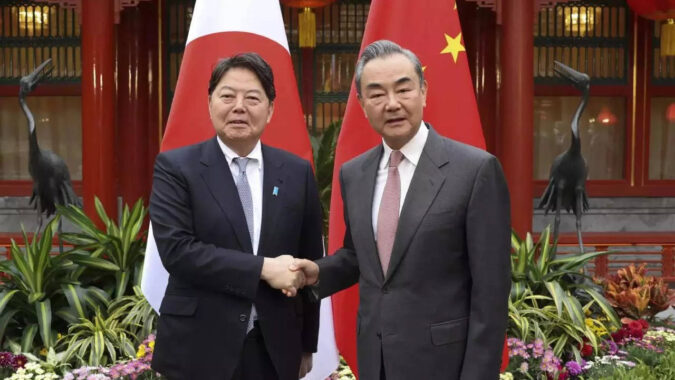TOKYO: Senior Japanese and Chinese government officials met on Monday to discuss maritime concerns in disputed waters in the East China Sea as Beijing conducted wargames around Taiwan.
The talks, part of a regular round of consultations on maritime affairs that began in 2012, come as Chinese warplanes and warships simulated strikes against Taiwan after the island’s President Tsai Ing-wen visited the United States, where she met U.S. House Speaker Kevin McCarthy.
Prior to the start of the talks, a top Japanese government spokesperson said Japan has been following China’s military drills around Taiwan consistently and “with great interest”.
“The importance of peace and stability in the Taiwan Strait is not only important for the security of Japan, but also for the stability of the international community as a whole,” Chief Cabinet Secretary Hirokazu Matsuno told reporters.
Beijing considers Taiwan as a part of China and regards meetings between senior U.S. and Taiwanese officials as interference in its internal affairs. It has not ruled out using force to bring what it views as a rogue province under its control.
China’s delegation was headed by Hong Liang, director-general of the Boundary and Ocean Affairs at China’s Foreign Ministry, while Japan’s side was led by director-general of Asian and Oceanian Affairs Takehiro Funakoshi.
During the last meeting in November, Hong criticized Tokyo for commenting on China’s activity in the Taiwan Strait, the waters that separate the island from the mainland. He also asked Japan to pull its ships back from the seas around islands in the East China Sea claimed by both countries.
Their coast guard ships regularly confront each other in the waters around the Japanese-controlled islands, which are known as the Senkaku in Japan and the Diaoyu in China.
While the United States has no position regarding the sovereignty of the territory, it has said it would regard any attempt by China to capture the islands as an attack on its ally.
China and Japan last month established a military communications hotline to help them defuse any air and sea incidents in the contested waters.
The talks, part of a regular round of consultations on maritime affairs that began in 2012, come as Chinese warplanes and warships simulated strikes against Taiwan after the island’s President Tsai Ing-wen visited the United States, where she met U.S. House Speaker Kevin McCarthy.
Prior to the start of the talks, a top Japanese government spokesperson said Japan has been following China’s military drills around Taiwan consistently and “with great interest”.
“The importance of peace and stability in the Taiwan Strait is not only important for the security of Japan, but also for the stability of the international community as a whole,” Chief Cabinet Secretary Hirokazu Matsuno told reporters.
Beijing considers Taiwan as a part of China and regards meetings between senior U.S. and Taiwanese officials as interference in its internal affairs. It has not ruled out using force to bring what it views as a rogue province under its control.
China’s delegation was headed by Hong Liang, director-general of the Boundary and Ocean Affairs at China’s Foreign Ministry, while Japan’s side was led by director-general of Asian and Oceanian Affairs Takehiro Funakoshi.
During the last meeting in November, Hong criticized Tokyo for commenting on China’s activity in the Taiwan Strait, the waters that separate the island from the mainland. He also asked Japan to pull its ships back from the seas around islands in the East China Sea claimed by both countries.
Their coast guard ships regularly confront each other in the waters around the Japanese-controlled islands, which are known as the Senkaku in Japan and the Diaoyu in China.
While the United States has no position regarding the sovereignty of the territory, it has said it would regard any attempt by China to capture the islands as an attack on its ally.
China and Japan last month established a military communications hotline to help them defuse any air and sea incidents in the contested waters.
